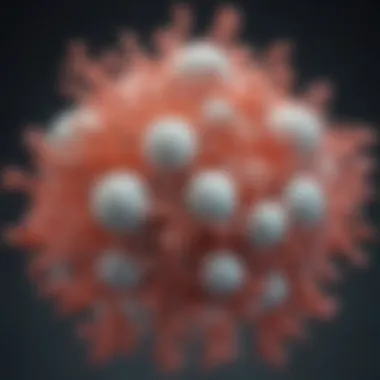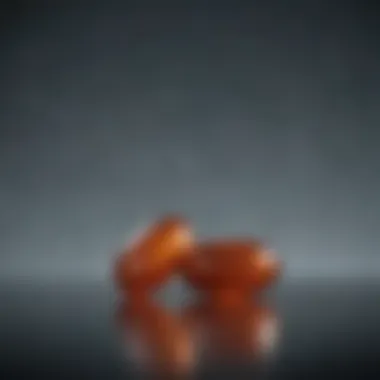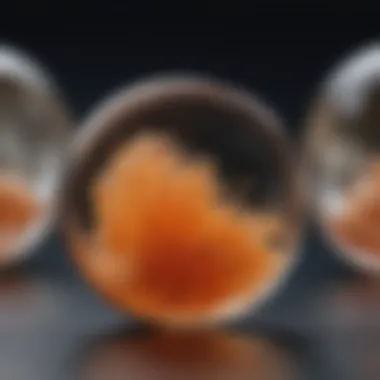Exploring Chitosan 300mg: Benefits and Applications


Overview of Research Topic
Brief Background and Context
Chitosan is a biopolymer derived from chitin, which is found predominantly in the shells of crustaceans such as shrimp and crabs. The transformation of chitin into chitosan involves a process called deacetylation. This substance has garnered significant interest in the scientific community due to its diverse applications, particularly at a dosage of 300mg. Researchers have shown that this specific amount can be effective in promoting various health benefits, which include aiding in weight management and lowering cholesterol levels. Chitosan’s efficacy lies in its ability to bind to dietary fats and cholesterol in the gastrointestinal tract, thus reducing their absorption into the bloodstream.
Importance in Current Scientific Landscape
In the current realm of health and wellness, there’s a strong emphasis on natural remedies and ingredients, making chitosan’s popularity a noteworthy topic. As the world shifts toward alternative and less invasive solutions for health issues, chitosan stands out for its multifunctionality. It not only offers potential health benefits but also serves as a biodegradable alternative to synthetic materials, thus contributing to sustainability efforts in various industries. The exploration of this biopolymer's properties and its potential implications in health, agriculture, and food technology is not only timely but critical for a holistic understanding of contemporary scientific progress.
Methodology
Research Design and Approach
This article adopts a comprehensive review methodology, aggregating findings from various research works and case studies related to chitosan and its applications. By collating data from different sectors where chitosan is applied, the review provides a robust analysis of its implications and effectiveness. The methodological framework centers on qualitative research combined with quantitative data wherever applicable, aiming to deliver a thorough synthesis of existing knowledge.
Data Collection Techniques
In compiling this narrative, a mix of peer-reviewed journals, academic articles, and empirical studies were referenced. The following techniques were employed:
- Literature Review: An extensive survey of scientific literature related to chitosan’s biochemical characteristics and its applications.
- Case Studies: Analysis of practical applications and results from clinical trials and observational studies that focus on chitosan’s effectiveness in health-related scenarios.
- Meta-Analysis: In some instances, studies were systematically reviewed to determine consensus findings regarding chitosan’s benefits.
"The science of chitosan informs us not only about its immediate benefits but also about its broader applications and implications in sustainability and health."
This structured approach ensures a clear understanding of the relevance of chitosan, particularly at a dosage of 300mg, and its potential to impact various fields significantly.
Preface to Chitosan
Chitosan has emerged as a significant biopolymer in the realms of health, agriculture, and food technology. Understanding chitosan is essential, especially when examining its unique properties and potential applications, particularly in the 300mg dosage. This introduction serves as a stepping stone to delve deeper into the implications and benefits of this fascinating polysaccharide. Initially derived from chitin, which is sourced from the shells of crustaceans, chitosan exhibits various attributes that make it a subject of interest in scientific circles. Researching chitosan opens avenues not only for enhancing health through various means but also for improving agricultural practices and developing sustainable food solutions.
Furthermore, as awareness of health and environmental issues grows, chitosan's multifaceted nature positions it as a valuable component across different fields.
What is Chitosan?
Chitosan, a biopolymer, stands out due to its unique chemical structure and properties. It is a derivative of chitin, which is a primary component in the exoskeletons of crustaceans, including shrimp and crabs. To create chitosan, chitin undergoes deacetylation, which essentially removes acetyl groups and transforms it into a more soluble form, expanding its functionalities.
In its purest form, chitosan is an off-white powder that is odorless and tasteless. It's not just the properties that are fascinating; it's what it can do. This substance is soluble in acidic environments, making it particularly useful in various applications ranging from health supplements to food preservation. Its biocompatibility and biodegradability are characteristics that align perfectly with today’s push for environmentally friendly solutions.
It's worth noting that chitosan is often used as a dietary supplement, with claims ranging from weight loss support to cholesterol management. As such, a deep dive into its benefits and mechanisms can provide significant insight into its role in modern health practices.
Historical Context and Discovery
The discovery of chitosan is an interesting tale intertwined with the exploration of marine biology and biotechnology. The chitin from which chitosan is derived was first identified as a material back in 1823 by Henri Braconnot. However, it wasn't until the 1930s that researchers, particularly in Japan, began to investigate its potential applications.
In the early days, chitosan's uses were largely limited to agriculture, where it proved beneficial in enhancing soil quality and plant health. As research advanced, so did the applications of chitosan, branching out into medicine and food technology. Researchers uncovered that chitosan had antimicrobial properties, opening doors to its use in wound healing and drug delivery systems.
By the late 20th century, chitosan began garnering attention in health circles, touted for its ability to manage weight and cholesterol levels. The evolving interest in natural and organic products has contributed to its resurgence. As more people seek alternatives to synthetic additives, the emphasis on discovering and applying chitosan continues to be relevant today.
Chitosan represents not only a link to our past, but a pathway to potential future advancements in health and sustainability.
Chemical Properties of Chitosan


Understanding the chemical properties of chitosan is pivotal for grasping its wide-ranging implications and applications in health, agriculture, and food technology. Since chitosan is derived from chitin, primarily found in the shells of crustaceans, its inherent characteristics play a significant role in how it interacts in various environments. From its structure to solubility, each facet contributes to its effectiveness and usability in multiple domains.
Structure and Composition
Chitosan is a polysaccharide composed of linear chains of N-acetylglucosamine and glucosamine. The degree of deacetylation, which is the proportion of glucosamine in the polymer chain, significantly influences its properties. Generally, a higher deacetylation degree enhances its solubility in acidic conditions, making it more effective in various applications.
- Key Features of Chitosan Structure:
- Linear arrangement of repeating units
- Amine groups confer positive charge under acidic pH
- Molecular weight variability affects its functional characteristics
This unique arrangement allows chitosan to exhibit biocompatibility, biodegradability, and non-toxicity, making it suitable for medical applications such as drug delivery systems. In the agricultural sector, its structure facilitates improved interactions with soil, enhancing nutrient absorption by plants.
Solubility and Stability
Solubility is one of the most critical chemical properties of chitosan. Under acidic conditions (pH 6), chitosan becomes soluble due to protonation of its amine groups. This property is not just a technical detail; it's a fundamental aspect that allows chitosan to form gels and films, which are crucial in food preservation and pharmaceuticals.
- Considerations about Solubility:
- pH Dependency: Higher solubility in acidic media opens avenues for applications in drug formulations.
- Stability: Chitosan can maintain its structural integrity over various environmental conditions, showcasing thermal and mechanical stability.
The stability of chitosan is of particular importance when it's employed as a food preservative or in packaging. It can withstand certain physical and chemical stresses, leading to longer shelf lives for foods treated with chitosan-based materials.
"The alignment of chitosan's solubility with environmental conditions not only informs its applications but also highlights the material's versatility in addressing industry-specific needs."
In summary, these chemical properties not only make chitosan applicable in a wide range of fields but also support ongoing research aimed at uncovering even more innovative utilizations. From boosting agricultural productivity to enhancing health outcomes, the structural intricacies and solubility characteristics of chitosan present opportunities that are just beginning to be explored.
Health Benefits of Chitosan
The exploration of chitosan, particularly at a dosage of 300mg, brings to light significant health benefits that span various aspects of human physiology. This biopolymer has gained traction in health and wellness sectors due to its potential positive impacts on cholesterol levels, weight management, and glucose regulation. Understanding these health benefits not only enables individuals to make informed decisions about their supplement intake but also inspires ongoing research into its broader implications.
Cholesterol Reduction
Cholesterol levels are pivotal indicators of cardiovascular health. Chitosan has been shown to interact with dietary fats within the gastrointestinal tract, forming a gel-like substance that binds to fat molecules. This binding prevents the absorption of fats by the intestinal walls. Some studies suggest that this mechanism can lead to significant reductions in low-density lipoprotein (LDL) cholesterol levels, often referred to as the "bad" cholesterol.
- A notable study conducted with participants consuming chitosan showed a decrease of approximately 10-15% in LDL cholesterol levels over a period of six weeks.
- It's noteworthy that the effectiveness of chitosan may vary depending on dietary habits and dosage. Therefore, integrating it as a supplement along with a balanced diet can amplify its potential benefits.
Furthermore, the impact of chitosan on overall cholesterol profiles raises valuable discussions in cardiovascular health. As cardiovascular diseases remain a leading cause of mortality worldwide, understanding how a natural compound like chitosan can play a role in managing cholesterol levels provides hope for preventive strategies.
Weight Management
The struggle with weight management is a common one, often compounded by lifestyle choices and metabolic factors. Chitosan has emerged as a potential ally in this battle. Through its fat-binding properties, it creates an environment that can reduce overall fat intake, thereby contributing to weight loss efforts.
- Research findings indicate that individuals supplementing with 300mg of chitosan, in conjunction with a caloric deficit, managed to shed pounds more effectively compared to those who did not.
- By inhibiting the absorption of dietary fats, this polysaccharide creates a sort of roadblock, making it more challenging for the body to store excess fat.
However, it's essential to approach chitosan as part of a broader weight management strategy that includes proper nutrition and exercise. Relying solely on supplements—no matter how potent—may not yield sustainable outcomes.
Glucose Regulation
For those concerned with blood sugar levels, chitosan presents another intriguing benefit. By potentially aiding in glucose regulation, it lends itself to diabetic management strategies. The interaction between chitosan and carbohydrate absorption has been a subject of several studies, suggesting that chitosan can help slow down the absorption of sugars in the digestive system.
- This slow absorption may help in moderating post-meal glucose spikes, which is critical for individuals managing insulin sensitivity.
- Consequently, incorporating 300mg of chitosan might contribute positively to overall metabolic health and add a layer of support for those at risk of developing type 2 diabetes.
In closing, the health benefits of chitosan, particularly in managing cholesterol, aiding in weight loss, and aiding glucose regulation, highlight its potential as a significant supplement. Nevertheless, individuals should consult with healthcare professionals to personalize their approach to dietary and lifestyle changes. The ongoing study of chitosan will undoubtedly contribute further to understanding its full range of benefits and risks.


Dosage Considerations: Chitosan 300mg
Understanding the appropriate dosage of chitosan, particularly at the 300mg level, is crucial to tap into its possible benefits. The quantity taken can influence not just effectiveness but also safety. While the science backing chitosan’s claims is extensive, the nuances of dosage deserve careful attention. Without proper guidance, users might not experience the full potential that chitosan offers, or they could expose themselves to unintended side effects.
Recommended Dosage
Chitosan is commonly recommended at dosages ranging from 500mg to 3000mg daily. However, a dosage of 300mg is considered a sensible starting point for many individuals dabbling with this supplement. It balances safety and effectiveness, especially for newcomers. This lower dose helps users to gradually incorporate chitosan into their routine without overwhelming their systems.
- General Guideline: For most adults, starting with 300mg can help gauge tolerance.
- Nutritive Factors: When considering the need for increased metabolism and fat binding, this dosage could be enough for those not actively engaging in weight loss programs.
Consulting a healthcare professional is often advised before beginning any supplementation, especially for individuals with existing health conditions or those on medication.
Potential Side Effects
While chitosan is generally considered safe, it's not entirely free from side effects. Users might experience slight gastrointestinal disturbances, particularly at higher doses. The following side effects are commonly reported:
- Nausea
- Constipation
- Diarrhea
- Stomach cramps
Chitosan can sometimes bind to nutrients, so it’s essential to monitor one's overall nutrient intake, especially if using it regularly. If any symptoms arise, adjusting the dosage or discontinuing use might be necessary.
"The key to dietary supplements is moderation; less might very well be more."
Interactions with Other Supplements
Interactions between chitosan and other dietary supplements can occur and warrant careful consideration. Chitosan has been known to bind with fatty acids and cholesterol, which may influence how other components are absorbed. Here are a few insights on potential interactions:
- Fat-Soluble Vitamins: Since chitosan may bind fats, it might also affect the absorption of vitamins such as A, D, E, and K.
- Medications: There is a potential for interaction with certain medications, especially those requiring fat for absorption. This includes some antihypertensives and anticoagulants.
- Other Fiber Supplements: Combining chitosan with other forms of fiber might enhance gastrointestinal effects, leading to discomfort.
For those considering introducing chitosan alongside other supplements, it’s prudent to consult a healthcare provider. As with any supplement, due diligence and awareness about interactions are paramount for safety and efficacy.
Applications of Chitosan in Various Fields
Chitosan, a biopolymer derived from chitin, is gaining considerable traction across different sectors. Its multifaceted nature makes it a valuable asset in medical, agricultural, and food technology advancements. This section delves into how chitosan is making waves in these fields, emphasizing its benefits, unique properties, and implications for future applications.
Medical Uses
Drug Delivery Systems
In the realm of medicine, chitosan's potential in drug delivery systems is proving to be a game changer. Researchers are turning to chitosan because of its biodegradable and biocompatible characteristics, making it a safer alternative compared to synthetic polymers. This material can encapsulate drugs, ensuring targeted delivery and controlled release, thereby enhancing the efficacy of pharmaceuticals. A unique feature of drug delivery systems that employ chitosan is their ability to respond to pH changes in the body, offering tailoring options in achieving desired therapeutic outcomes. However, one must consider the challenges of scale-up production and consistency in batch quality, which need careful attention to harness chitosan’s full potential.
Wound Healing Applications
Chitosan also shines in wound healing applications, where its natural properties promote tissue regeneration. It acts as a protective barrier while facilitating moisture retention at the wound site, which is crucial for recovery. The key characteristic here is its antimicrobial properties, which are invaluable for preventing infections in healing wounds. The unique formulation of chitosan, combined with other biomaterials, showcases its versatility in developing innovative wound dressings. Though more research is necessary to pinpoint optimal application methods and long-term effects, the initial results indicate a promising path forward in enhancing patient care.
Agricultural Applications
Pesticide Development
When it comes to pesticide development, chitosan is often touted as an organic alternative. With growing concerns about chemical residues in food, chitosan provides an eco-friendlier option capable of enhancing crop yields without harming the environment. Its natural ability to repel pests while providing some level of nutrient support to the plants captures attention in sustainable agricultural practices. A unique feature of chitosan-based pesticides is their capacity to degrade naturally over time, leaving no toxic remnants behind. Despite these advantages, the efficacy in varying climatic conditions and pest species is still under exploration, indicating further studies are essential.
Plant Growth Enhancement
Chitosan’s role in plant growth enhancement cannot be overlooked. Studies have shown that applying chitosan fosters strong growth by stimulating various physiological processes in plants. For instance, it enhances seed germination, root development, and overall plant vigor. The key attribute is its capability to enhance the plants’ defenses against diseases, thus promoting resilience in adverse conditions. Another unique aspect is how chitosan’s application can reduce the need for chemical fertilizers, aligning with sustainable farming practices. However, the cost of sourcing and applying chitosan remains a consideration for wide-scale adoption in the agricultural sector.


Food Technology and Preservation
Food Additive Potential
In food technology, the food additive potential of chitosan opens doors for healthier consumption options. It can act as a natural preservative, extending shelf life by inhibiting the growth of molds and bacteria. The key characteristic making it a popular choice is its non-toxic nature, appealing to health-conscious consumers. A remarkable feature of chitosan is its ability to form films that can envelop food items, thus keeping them fresh without compromising quality. However, variations in taste and texture might occur, which must be assessed to ensure consumer acceptance.
Biodegradable Packaging Solutions
Finally, chitosan is at the forefront of biodegradable packaging solutions. As the world grapples with the consequences of plastic pollution, chitosan offers a promising alternative that degrades naturally and supports detoxifying the environment. The critical aspect here is that it can be molded into different shapes and forms, allowing customization for various packaging needs. Nevertheless, scalability and production costs pose challenges that need addressing for it to replace conventional materials widely.
Chitosan is not just another compound; it stands as a testament to how natural substances can be harnessed to innovate across various fields, pushing the boundaries of technology and sustainability.
In summary, the applications of chitosan in medicine, agriculture, and food technology highlight its incredible versatility. Each sector witnesses unique contributions of chitosan, suggesting that further exploration could unlock even more of its potential benefits.
Chitosan in the Research Landscape
The significance of chitosan in the research arena cannot be overstated. This biopolymer, derived from chitin, has received attention for its vast potential across various domains ranging from healthcare to agriculture. The exploration of chitosan's properties and its impact on different industries has fueled an increasing interest among scientists and researchers. This section aims to illuminate the latest findings and future research pathways, shedding light on chitosan's implications and applications in contemporary science.
Recent Studies and Findings
In recent years, a myriad of studies has sought to unravel the benefits and functional capabilities of chitosan, often highlighting its multifaceted nature.
One significant finding is the role chitosan plays in drug delivery systems. Researchers have discovered that its biocompatibility and biodegradability make it an ideal candidate for creating nanoparticles that can transport drugs to target sites in the body. For instance, a 2022 study published in the Journal of Drug Delivery Science and Technology demonstrated that chitosan nanoparticles effectively improved the bioavailability of specific medications, thereby enhancing therapeutic efficacy.
Moreover, the agricultural sector has benefited from advances in chitosan research. A study from 2023 revealed that chitosan could significantly bolster plant resistance to pathogens. By acting as a natural pesticide, it reduces agricultural chemical usage and promotes environmentally friendly practices. In this context, chitosan's potential extends to enhancing soil quality and crop health, fostering sustainable agriculture practices.
Some additional findings are:
- Chitosan's role in wound healing has also garnered attention. It has been highlighted for its antimicrobial properties, which aid in preventing infections and accelerating tissue regeneration.
- Furthermore, oil industry researchers indicated an interesting application of chitosan in bio-remediation processes, where it is utilized to absorb oil spills due to its high adsorption capacity.
Future Directions in Research
The future of chitosan research holds great promise. As scientists continue to explore its diverse applications, several opportunities lie on the horizon:
- Enhanced Formulations: Researchers are focusing on creating modified chitosan formulations that could improve its solubility and efficacy, thereby widening its application scope. This includes potential enhancements for pharmaceutical applications in personalized medicine.
- Integration with Nanotechnology: Chitosan's compatibility with nanoparticles opens the door for interdisciplinary research, merging biotechnology, nanotechnology, and materials science. These multidisciplinary efforts can lead to groundbreaking treatments in drug delivery and tissue engineering.
- Environmental Impact Studies: Emerging research may delve into chitosan's role in environmental science, particularly its use in wastewater treatment and pollution control. Exploring its effectiveness as a sorbent material could lead to exciting developments in ecological preservation.
The roadmap ahead for chitosan not only points toward expanded applications but also emphasizes the importance of collaborative research efforts. Bringing together specialists from various fields will enhance the understanding and application of chitosan, providing solutions to complex global challenges in health, food security, and environmental sustainability.
Chitosan is more than just a supplement; it’s on the frontier of innovative research with wide-ranging possibilities.
As scientific inquiry advances, chitosan's role in transformative applications remains a topic of extensive interest, warranting ongoing investigation and discussion.
End
The conclusion of this exploration into chitosan, particularly at the dosage of 300mg, underscores the significance of understanding both its potentials and limitations in various fields. Chitosan is not just another health supplement; it embodies the intersection of science and practicality. The detailed insights presented earlier highlight how this biopolymer can play crucial roles in health, agriculture, and food technology. This multilayered narrative encourages a deeper appreciation of chitosan—a substance that carries ample promise yet must be approached with thoughtful consideration.
Summary of Key Insights
The investigation into chitosan reveals several key insights:
- Health Benefits: Chitosan has demonstrated efficacy in several health domains, particularly in cholesterol reduction and weight management. These attributes have been substantiated through various studies, suggesting that a daily intake of 300mg can yield tangible results.
- Versatile Applications: Beyond individual health benefits, chitosan plays a noted role in various sectors. For instance, its applications in medical delivery systems and agricultural enhancement highlight its multifunctionality.
- Safety and Interactions: The conclusion also emphasizes the necessity for awareness regarding dosage and potential interactions with other substances. While chitosan is considered largely safe, understanding individual health profiles remains essential for its effective use.
Implications for Future Research
Looking ahead, there’s a vast landscape of opportunities for future research into chitosan. Some crucial areas of focus might include:
- Expanded Health Applications: Investigating more health-related applications of chitosan, particularly in complex conditions like diabetes or obesity.
- Innovative Delivery Methods: Exploring novel ways to enhance the delivery efficiency of chitosan-based drugs or supplements can open up new therapeutic avenues.
- Ecological Impact: Given the growing emphasis on sustainability, understanding the environmental implications of chitosan production and its biodegradable properties offers an intriguing field of study.
Chitosan’s journey from a natural polymer to a key player in modern applications reflects an exciting narrative in pharmaceuticals, agriculture, and nutrition. The possibilities appear limitless, but informed exploration is paramount.



